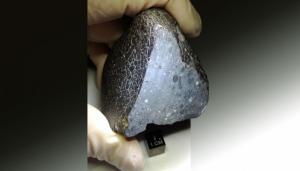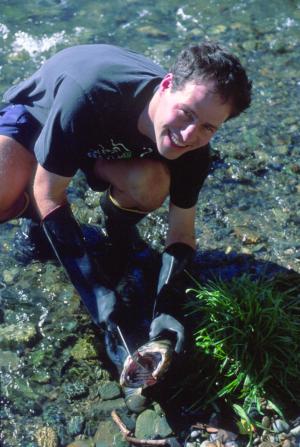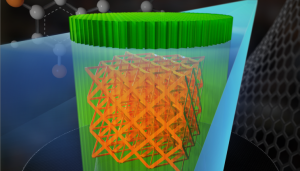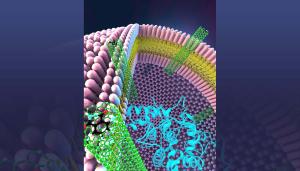LAB REPORT
Science and Technology Making Headlines
Jan. 12, 2018


LLNL research shows that trapped gasses in ancient Martian meteorites pin down the timing and effectiveness of atmospheric escape processes that have shaped Mars’ climate.
Red planet dried up at an early age
The time when ancient Mars was warm, wet and comfortable for alien life may have been quite short -- new research suggests Earth’s planetary neighbor has been dried up for billions of years.
Meteorites that are believed to have come from Mars and crashed down on Earth contain gases that indicate when Mars transformed, according to a study by Lawrence Livermore scientist Bill Cassata. Specifically, the xenon in the two rocks provide evidence for atmospheric loss early in planetary history. According to the study, the way xenon isotopes formed in the meteorites holds clues about when gases and liquids escaped.
The loss of atmosphere happened perhaps a few hundred million years after the planet formed. This differs significantly from Earth, where xenon escape was a gradual process that occurred throughout much of planetary history, indicating that atmospheric dynamics on the two planets diverged early in the history of the solar system.


LLNL geochemist Peter Weber collects salmon ear bones in Battle Creek in the northern Central Valley. Photo by Fred Feyrer/California Department of Water Resources.
Fish out of its usual waters
Like all salmon, Sacramento River winter run chinook salmon reproduce (spawn) in freshwater. Their offspring migrate to the ocean as juveniles, where they feed and mature before returning to their natal stream to renew the cycle.
However, the timing of these movements differ dramatically among salmon species and populations. Winter run exhibit behaviors so unique that they are treated as a separate “species” by the Endangered Species Act (ESA) and were the first Pacific salmon to be state and federally listed as endangered in 1989 and 1994, respectively.
In a new study, researchers from the Metropolitan Water District of Southern California, UC Davis Center for Watershed Sciences, NOAA Fisheries, and Lawrence Livermore used salmon otolith (ear bone) chemistry to reveal the migration patterns and secret hang-out spots used by juvenile winter run on their way to the ocean.
The surprising finding was that, in their youth, around half the successful winter run adults had wandered beyond their natal reach of the Sacramento River to feed and grow before continuing their journey to the ocean. These alternative “non-natal” habitats included Deer, Mill, Battle Creeks, the Delta, Feather and American Rivers, most of which is not designated as critical habitat under the ESA.


Extent of Arctic sea ice in September 2016 versus the 1981-2010 average minimum extent (gold line). Through satellite images, researchers have observed a steep decline in the average extent of Arctic sea ice for every month of the year. Image courtesy of NASA
Climate at a tipping point
In 2017, the world got a look at what scientists have warned about for decades: climate change can make extreme events like droughts, floods, hurricanes and wildfires more frequent.
Melting glaciers and sea ice are particularly worrisome because they trigger critical secondary effects, notably increasing rates of sea-level rise.
This development also sets up dangerous climate feedback loops as reflective white snow and ice turn into heat-absorbing dark-blue water. It means the Arctic will send less heat back into space, which leads to more warming, more melting, and more sea-level rise still.
Lawrence Livermore National Lab researchers highlighted yet another potential effect of declining Arctic sea ice, concluding it may have played a crucial role in California’s extended drought this decade and could exacerbate future droughts.


Lawrence Livermore researchers can print woodpile lattices with submicron features a fraction of the width of a human hair. Image by Jacob Long and Adam Connell/LLNL
It’s all in the small print
Creating 3D printing features smaller than a width of a human hair has its challenges.
But Lawrence Livermore researchers have overcome those challenges by uncovering a new piece to the two-photon lithography puzzle that maximizes the possibilities of the technology, especially for use in medicine.
Two-photon lithography can 3D print features that are much smaller than the resolution of a laser beam curing source. This is made possible by a lens/glass plate arrangement that filters the laser into a fine focal spot.
Two-photon lithography machines typically 3D print from the bottom up. In LLNL’s research, this process is literally turned on its head, enabling what is termed “dip-in laser lithography.”


An artist’s depiction of the promise of carbon nanotube porins for desalination. The image depicts a stylized carbon nanotube pipe that delivers clean desalinated water from the ocean to a kitchen tap. Image by Ryan Chen/LLNL
Seeing the water through exascale
Though nearly 70 percent of Earth’s surface is comprised of water, only 3 percent is considered naturally potable -- and most of it is safeguarded, trapped in glaciers or polar ice caps.
Researchers at Lawrence Livermore believe the answer lies in carbon nanotubes. The microscopic cylinders serve as the perfect desalination filters -- their radii are wide enough to let water molecules slip through, but without enough room to diffuse the larger salt particles.
The width of a single nanotube is more than 10,000 times smaller than that of a human hair. Fasten a few billion of these nanotubes together, and the result is an effective device for producing drinkable seawater. Finding an optimal configuration for billions of microscopic cylinders is easier said than done, and scientists hope to use supercomputing as the next-generation method to do so.





